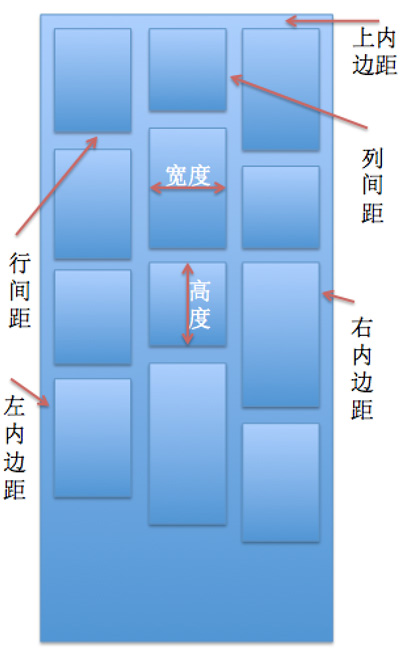iOS之简单瀑布流的实现
前言
超简单的瀑布流实现,这里说一下笔者的思路,详细代码在这里。
效果演示

实现思路
collectionView能实现各中吊炸天的布局,其精髓就在于UICollectionViewLayout,因此我们要自定义一个layout来继承系统的UICollectionViewLayout,所有工作都在这个类中进行。
1.定义所需属性
瀑布流的思路就是,从上往下,那一列最短,就把下一个item放在哪一列,因此我们需要定义一个字典来记录每一列的最大y值
每一个item都有一个attributes,因此定义一个数组来保存每一个item的attributes。
我们还必须知道有多少列以及列间距、行间距、section到collectionView的边距。

//总列数 @property (nonatomic, assign) NSInteger columnCount; //列间距 @property (nonatomic, assign) NSInteger columnSpacing; //行间距 @property (nonatomic, assign) NSInteger rowSpacing; //section到collectionView的边距 @property (nonatomic, assign) UIEdgeInsets sectionInset; //保存每一列最大y值的数组 @property (nonatomic, strong) NSMutableDictionary *maxYDic; //保存每一个item的attributes的数组 @property (nonatomic, strong) NSMutableArray *attributesArray;
2.重写系统方法
我们一共需要重写4个方法
1)- (void)prepareLayout 2)- (CGSize)collectionViewContentSize 3)- (UICollectionViewLayoutAttributes *)layoutAttributesForItemAtIndexPath:(NSIndexPath *)indexPath 4)- (NSArray *)layoutAttributesForElementsInRect:(CGRect)rect
- (void)prepareLayout 方法
布局前的一些准备工作都在这里进行,初始化字典,有几列就有几个键值对,key为第几列,value为列的最大y值,初始值为上内边距:
for (int i = 0; i < self.columnCount; i++) { self.maxYDic[@(i)] = @(self.sectionInset.top); }创建每个item的attributes,并存入数组:
//根据collectionView获取总共有多少个item NSInteger itemCount = [self.collectionView numberOfItemsInSection:0]; //为每一个item创建一个attributes并存入数组 for (int i = 0; i < itemCount; i++) { UICollectionViewLayoutAttributes *attributes = [self layoutAttributesForItemAtIndexPath:[NSIndexPath indexPathForItem:i inSection:0]]; [self.attributesArray addObject:attributes]; }- (CGSize)collectionViewContentSize 方法
用来计算collectionView的contentSize
一般瀑布流只能垂直滚动,不能水平滚动,因此contentSize.width = 0,我们只需要计算contentSize.height即可
从字典中找出最长列的最大y值,再加上下面的内边距,即为contentSize.height
- (CGSize)collectionViewContentSize { //假设第0列是最长的那列 __block NSNumber *maxIndex = @0; //遍历字典,找出最长的那一列 [self.maxYDic enumerateKeysAndObjectsUsingBlock:^(NSNumber *key, NSNumber *obj, BOOL *stop) { //如果maxColumn列的最大y值小于obj,则让maxColumn等于obj所属的列 if ([self.maxYDic[maxIndex] floatValue] < obj.floatValue) { maxIndex = key; } }]; //collectionView的contentSize.height就等于最长列的最大y值+下内边距 return CGSizeMake(0, [self.maxYDic[maxIndex] floatValue] + self.sectionInset.bottom); }- (UICollectionViewLayoutAttributes *)layoutAttributesForItemAtIndexPath:(NSIndexPath *)indexPath 方法
该方法则用来设置每个item的attributes,在这里,我们只需要简单的设置每个item的attributes.frame即可
首先我们必须得知collectionView的尺寸,然后我们根据collectionView的宽度,以及列数、各个间距来计算每个item的宽度
item的宽度 = (collectionView的宽度 - 内边距及列边距) / 列数

CGFloat collectionViewWidth = self.collectionView.frame.size.width; //self.sectionInset.left:左边距 self.sectionInset.right:右边距 //(self.columnCount - 1) * columnSpacing:一行中所有的列边距 CGFloat itemWidth = (collectionViewWidth - self.sectionInset.left - self.sectionInset.right - (self.columnCount - 1) * self.columnSpacing) / self.columnCount;
接下来计算item的坐标,要想计算坐标,那就必须知道最短的那一列,先遍历字典,找出最短列是哪一列(minColumn)以及其最大y值。
item的y值就等于最短列的最大y值再加上行间距,x值就等于左边距 + (item宽度 + 列间距) * minColumn

//找出最短的那一列 __block NSNumber *minIndex = @0; [self.maxYDic enumerateKeysAndObjectsUsingBlock:^(NSNumber *key, NSNumber *obj, BOOL *stop) { if ([self.maxYDic[minIndex] floatValue] > obj.floatValue) { minIndex = key; } }]; //根据最短列的列数计算item的x值 CGFloat itemX = self.sectionInset.left + (self.columnSpacing + itemWidth) * minIndex.integerValue; //item的y值 = 最短列的最大y值 + 行间距 CGFloat itemY = [self.maxYDic[minIndex] floatValue] + self.rowSpacing;接下来便是item的高度,我们应该根据图片的原始尺寸以及计算出来的宽度,等比例缩放来计算高度,但是在layout类中,我们是拿不到图片的,因此我们可以定义一个block属性,或者代理,让外界来计算并返回给我们,我们需要将item的宽度以及indexPath传递给外界:
@property (nonatomic, strong) CGFloat(^itemHeightBlock)(CGFloat itemHeight,NSIndexPath *indexPath);
根据返回值来设置item的高度:
if (self.itemHeightBlock) itemHeight = self.itemHeightBlock(itemWidth, indexPath);
最后设置attributes的frame并更新字典:
//设置attributes的frame attributes.frame = CGRectMake(itemX, itemY, itemWidth, itemHeight); //更新字典中的最短列的最大y值 self.maxYDic[minIndex] = @(CGRectGetMaxY(attributes.frame));
- (NSArray *)layoutAttributesForElementsInRect:(CGRect)rect 方法
该方法用来返回rect范围内,item的attributes
直接返回attributesArray即可
- (NSArray *)layoutAttributesForElementsInRect:(CGRect)rect { return self.attributesArray; }使用
布局类写完了,接下来就可以直接使用了
//创建布局对象 XRWaterfallLayout *waterfall = [[XRWaterfallLayout alloc] init]; //设置相关属性 waterfall.columnCount = 3;//共多少列 waterfall.columnSpacing = 10;//列间距 waterfall.rowSpacing = 10;//行间距 waterfall.sectionInset = UIEdgeInsetsMake(10, 10 , 10, 10);//内边距 [waterfall setItemHeightBlock:^CGFloat(CGFloat itemWidth, NSIndexPath *indexPath) { //根据图片的原始尺寸,及显示宽度,等比例缩放来计算显示高度 XRImage *image = self.images[indexPath.item]; return image.imageH / image.imageW * itemWidth; }]; collectionView.collectionViewLayout = waterfall; ...... ......具体代码请到这里下载:https://github.com/codingZero/XRWaterfallLayout,觉得不错的,请献上你的star











![[HBLOG]公众号](http://www.liuhaihua.cn/img/qrcode_gzh.jpg)

